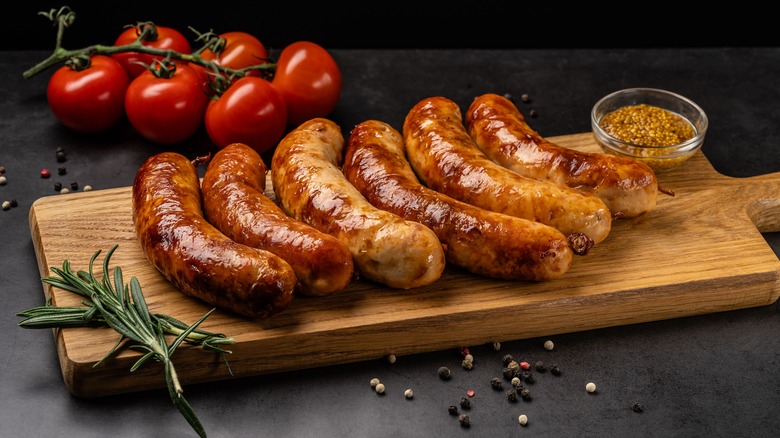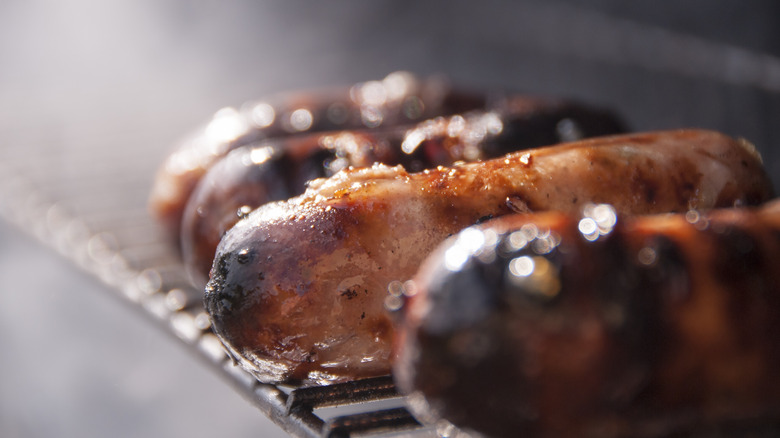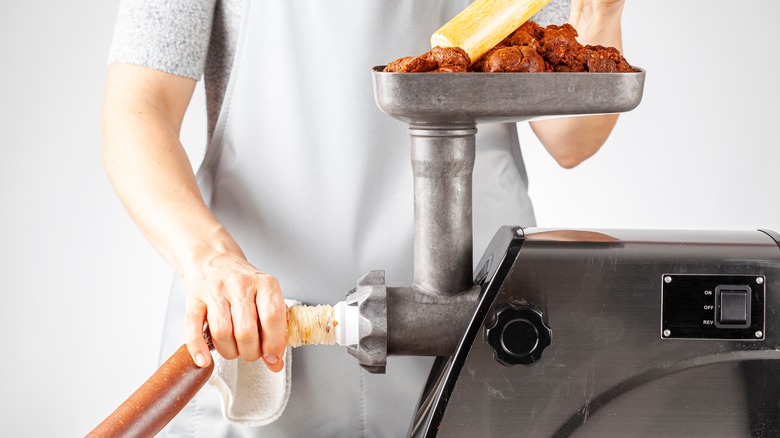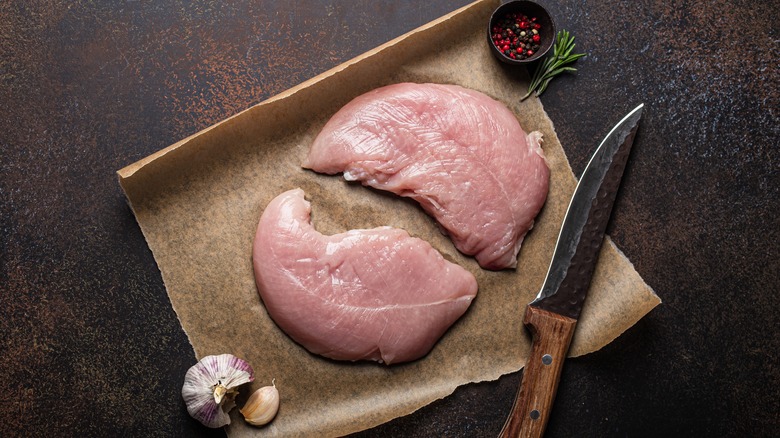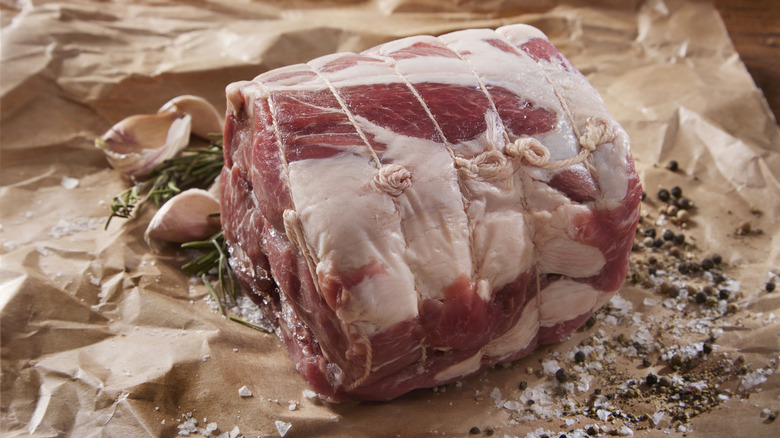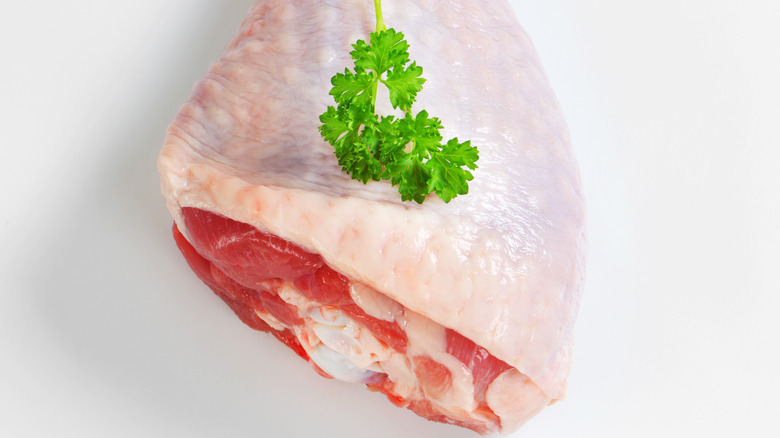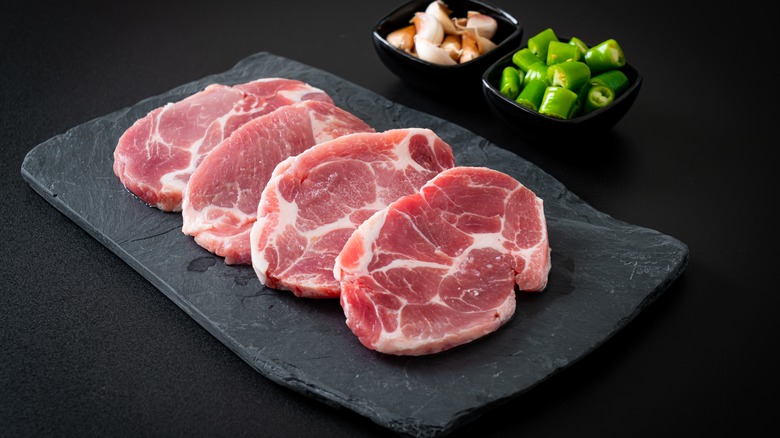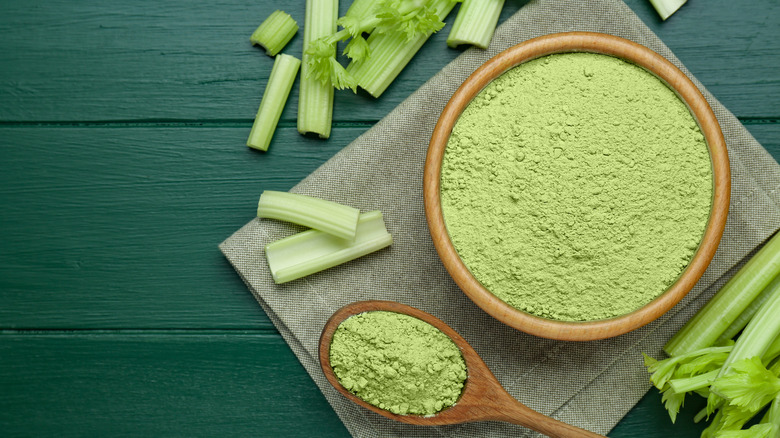Turkey Sausage Vs Pork Sausage: Everything You Need To Know
Turkey and pork sausage are grocery staples. Turkey is often seen as a healthier alternative to pork, but pork remains popular and is the go-to sausage for many cooks. Both taste great and are available in a number of varieties, such as kielbasa and breakfast sausage. However, depending on how they were produced, you'll have to expect turkey and pork sausages to taste at least a little bit different. You can also make your own sausage with either meat, and play around with the seasonings to see if you can reproduce the flavor of one meat while using the other.
The two are also similar in a lot of ways — and their differences aren't always what you'd expect. They're generally interchangeable in recipes, with one notable exception. Take a look at how turkey and pork sausage are alike and how they differ, and that may help you decide on which one to use the next time you cook with sausage.
What is turkey sausage?
Turkey sausage is literally just sausage made with turkey meat. It's a leaner type of sausage that became popular in the 1980s when eating low-fat foods was all the rage. The saturated fat of pork sausage became an unwelcome guest in many homes, but turkey sausage was there to enable consumers to continue eating it with their favorite breakfast and dinner recipes. The lack of fat in many brands means cooking turkey sausage is somewhat different from cooking pork sausage, but turkey still cooks up quickly.
Due to its low calorie count, turkey sausage is often promoted in weight loss diets. It's easy to unintentionally increase the calorie count of the sausage, though, so you have to be careful when choosing a brand to buy and careful about how you cook the sausage. Many recipes require adding oil or other fats when cooking, which increases the calories substantially.
What is pork sausage?
Pork sausage is simply sausage made with pork meat. It differs from turkey sausage mainly in nutrition and taste. It's the classic U.S. sausage meat; if someone tells you to add sausage to something, they're likely referring to pork unless they've said that you could add any type you like. It comes in both cooked and uncooked forms, so you have to be sure you know what you've bought; cooked sausage should still be warmed up to a safe temperature.
Pork sausage has a well-deserved reputation for being fatty, greasy, and excellent to eat because of its intense flavor. It grills and fries up wonderfully, and you can use it in everything from a skillet or sheet-pan meal to the Argentinian sandwich called choripán. It's affordable and easy to find, and it pairs well with most vegetables, grains, and even other proteins like eggs in a breakfast burrito.
Turkey is often leaner, which affects its taste
A recurring theme regarding pork and turkey sausage involves the fat. Pork cuts contain a great amount of fat, while turkey doesn't contain much at all in the meat but has a greater amount of fat in the skin. Sausage experts hold up pork fat back and belly fat as two of the best pork fats to use in sausage, while not mentioning turkey fat at all because there's so little of it in and around the meat.
While this is a boon for anyone looking to cut fat and calories, it gives turkey sausage a big disadvantage. Less fat means less taste. Turkey sausage will definitely have a flavor, especially if it contains lots of herbs and spices, but it won't be as robust as the flavor of pork sausage. The melting fat surrounding the meat as it cooks produces this tantalizing smell and taste that aren't really present with turkey sausage because of the lower amounts of fat.
Turkey can be (but isn't always) kosher or halal
If you or someone you know follows kosher or halal dietary rules or just wants to avoid all pork, then turkey sausage seems like a fantastic option as long as you don't combine the sausage with a dairy product. Turns out that this isn't always true, and turkey sausage can sometimes contain very non-kosher and non-halal ingredients.
Some turkey sausage is actually a combination of turkey and pork meat; this isn't that rare in homemade recipes. Commercial brands, of course, will list pork if it's an ingredient, so check those labels when you buy turkey sausage. A lot of turkey sausage uses pork casings, which makes those sausages not suitable for people needing to avoid pork. And then there's the issue of making your own sausage in a kitchen that hasn't been properly set up as kosher or halal; that alone could be an issue for those who observe religious dietary laws to the letter. Your best options are to always check the ingredient labels and to search specifically for sausages marked as halal or kosher.
Both can come in link, patty, ring, and ground forms
This shouldn't come as a surprise, but it's worth noting that both pork and turkey sausage come in link, patty, ring, and ground forms. This is an advantage because it means you can find the right shape or form of sausage meat for your recipe no matter what type of meat you choose.
It also helps a lot if you want to make your own sausage but aren't keen on having to grind the meat yourself or mix up a spice blend; just pick up a chub of sausage meat and form the number of patties you need. If you don't like the casings used for links, you can buy patties that don't use any casings. And if you want a lot of sausage but don't like the four- or five-link packages, you can find ring versions in a horseshoe or coil shape.
Turkey sausage is usually lower in calories
Protein, fat, and carbohydrates are macronutrients, and fat is the macronutrient that really adds calories. Protein and carbohydrates have about 4 calories per gram, and fat has about 9 calories per gram. Something lower in fat is going to be much lower in calories than a high-fat counterpart. Turkey meat without the skin is very lean. Even the thighs are lean, despite having a little more fat than turkey breasts. Because turkey meat doesn't have as much fat as pork meat, turkey ends up being lower in calories than pork when you compare similar amounts of the two meats.
However, two things can make turkey sausage soar in calories. One is that some turkey sausage meat contains ground-up skin as well as the muscle, and that increases the amount of fat in the sausage. Just adding skin to a piece of plain turkey can more than double the amount of fat. The other is that cooking can eliminate any calorie and fat savings by adding excessive amounts of oil or other fat to whatever recipe you're making. So, while turkey sausage is a great substitute in general, check out the nutrition label on the package or make it yourself to ensure you're getting the low-calorie, low-fat food you wanted, and be cautious about how much fat you add during cooking.
The types of spices used aren't necessarily different
You'd think that if manufacturers were going to make a type of sausage that consumers could use in place of another because of the fat content of the meat, they'd want the replacement sausage to taste as much as possible like the sausage they're replacing. But that's not always what happens with pork and turkey sausage, and it's not just because of the meats used. You'll often find them flavored with different spices and herbs, such as sage or rosemary for turkey and black pepper and garlic for pork. That's not to say you can't use black pepper with turkey or can't try to make one taste like the other, of course, but if you buy packs of pork and turkey sausages at a store, you shouldn't expect them to taste exactly the same.
The one exception appears to be breakfast sausage. That tends to be associated with a couple of specific flavors, notably sage, which is your basic breakfast sausage flavor, and maple. Commercial producers often use ingredients like natural flavors to enhance or change the flavor of a product, which makes it easier for them to make breakfast sausage taste like breakfast sausage, no matter the meat used.
Which one tastes better is a controversial topic
Put simply, neither pork nor turkey sausage tastes better or worse than the other. How they taste depends on the flavorings and fats used, the cooking method, and your personal taste. Maybe the way you cooked that turkey sausage made it taste better to you than the way you tried to cook the pork version, or maybe you just really prefer pork in general. There's no objective determination of which is better.
That said, people still treat the question of which tastes better as a somewhat controversial topic. Some regard the idea of pork tasting better as a given, such as this blog entry from Cathead's BBQ calling a comparison between the two "A Choice Between Tasty and Lean Sausage," implying that turkey isn't tasty. Fans of turkey products announce their love for the product on sites such as the Unpopular Opinion subreddit, which is a clue right there that they realize their opinion might not find many in agreement. It may seem as though there's a competition, but really, there's room for both types of sausage meat in this world.
Both tend to contain cheap cuts
One thing turkey and pork sausage have in common is that the sausages usually use cheaper cuts. That doesn't mean the cuts are bad by any means, and you can have sausage that contains more expensive cuts; it's just not that common. The point of making sausage was to ensure that all edible meat could be preserved and used. While commercially made sausages are now formulated mainly with taste and cut quality in mind, that origin in ensuring nothing edible was thrown away still shows up in the use of less expensive cuts.
Pork sausage tends to use the leg, shoulder, and belly, all of which are tasty but comparatively inexpensive parts. Turkey sausage is often made with thighs, which are cheap, and the sausage may also contain drumstick meat. Some turkey sausage brands may mix in turkey skin to increase the fat content and flavor. By the way, if you decide to make turkey sausage (e.g., breakfast patties) at home using ground turkey, you'll most likely have a combination of thighs and drumsticks in that meat unless you specifically look for ground turkey breast. Also, keep in mind that supply chain issues and laws requiring producers to change equipment may cause cuts to rise in price, which can make producers increase prices or change the cuts they use.
Turkey sausage is a relatively new product
Sausage has been around for centuries, but turkey sausage as a mainstream grocery product is comparatively new. Go to most markets today and you'll find turkey, chicken, and pork sausage all in the same section, with many brands offering both turkey and pork versions of kielbasa and other types of sausage. Go back a few decades, though, and you'll find sausage selections devoid of these alternatives.
Back before the 1970s, turkey wasn't eaten that much. It showed up at Thanksgiving, but it had only a small share of the non-holiday market. According to the National Turkey Federation, U.S. turkey consumption was only 8.2 pounds per capita in 1970 (for comparison, in 2021, it was 15.3 pounds per capita). In the 1980s, the push for leaner meat and low-fat meals put turkey in the spotlight. Ground turkey became much easier to find in stores, and eventually, companies tried turning turkey into sausage. It was a hit.
The interaction between liquid and fat is behind pork sausage's popularity
Look up a sausage recipe, and you'll likely find pork sausage as the main ingredient unless you specify another type of meat in your search. Given that you can make sausage with any meat, why is pork the default in so many recipes? Much of it has to do with how the liquid in the pork, or pork juice, reacts with the fat as the mixture heats up and the fat melts. When you cook meat, the proteins in the muscle portion lose water. This is why cooked lean meat can be so dry; there's little liquid left. But add in some melting fat during cooking, and you get a tasty, tender piece of meat. Pork has a great combination of fat and moisture that work together very well in cooking.
Pork has another advantage that's made it a top sausage meat. The meat has a sweeter aspect to it that helps preserve the flavor when curing salts and brines are added. Turkey doesn't have that advantage. While many sausages are made with thigh meat, the thigh meat is only slightly fattier than turkey breast meat, which is very lean. Turkey sausage can taste great, but the meat doesn't have the same inherent advantages as pork for sausage making.
Both come in minimally processed and ultra-processed forms
Most of what you eat is processed at least a little. For example, a sliced apple is technically processed because slices are not the apple's natural form. But many foods are ultra-processed, meaning that they've gone through substantial changes from their original form, often with the addition of artificial ingredients like flavoring. Much of the sausage available in grocery stores is considered ultra-processed because it's been cured with nitrates and nitrites. However, you can find sausages that are really just ground meat with spices, meaning the processing is minimal.
The past few years have seen a backlash against processed foods. Companies have removed a lot of artificial ingredients and replaced artificial additives with more recognizable substances, such as adding beet juice for color. For sausage, it's common to find brands that claim their sausage contains no added nitrites or nitrates, which gives the impression that these are less processed than conventional sausages. However, those claims are often accompanied by an asterisk with a footnote stating that the product contains celery powder, which naturally contains nitrates that your body converts to nitrites. If you're looking for minimally processed sausage, look for products that are just ground meat and spices without anything like celery powder. Note that a number of vegetable powders that also lead to nitrite formation can be used in place of celery powder.
Pork sausage's fat content is vital for breakfast gravy
Both pork and turkey sausage work in any sausage-containing recipe; while the turkey version may taste different, you can minimize that difference by using the right spices. However, there's one dish where using pork sausage makes preparation much simpler: breakfast gravy. Traditional breakfast gravy is simple; brown some sausage, use the resulting drippings to form a roux with flour and milk, and mix everything together. Fat is necessary for the very structure of the roux. Without enough fat, you can't make the gravy, and pork sausage is fatty enough to usually produce enough drippings.
You can make good breakfast gravy with another type of sausage meat, or even a non-meat product. But whatever you use in place of pork sausage has to be cooked in extra fat, such as bacon fat, shortening, or butter, to produce enough drippings for the roux. If you can't have pork for whatever reason, don't use it. But if you can? Use it, because it eliminates the extra steps of finding the right type of fat that will taste good with your sausage substitute, and of figuring out the right amount of fat to add.
The one exception may be if you're making the gravy in Australia. An Australian Redditor tried to make American breakfast gravy and found that Australian pork was just too lean. The best substitute they found, believe it or not, was Australian ground turkey.
